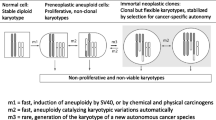Abstract
A highly oncogenic monkey adenovirus SA7(C8) facilitates the reproduction of human adenovirus type 2 (Ad2) in monkey cells. Upon mixed infection of monkey cells with both viruses, these viruses recombine producing defective adeno-adeno hybrids Ad2C8 serologically identical to Ad2 and capable of assisting Ad2 to reproduce in monkey cells. Ad2C8 and Ad2 form an intercomplementary pair inseparable in monkey cells. Unlike oncogenic SA7(C8), Ad2C8 is a nononcogenic virus for hamsters but is able to induce tumor antigens of this virus (T and TSTA). Molecular genetic analysis of 68 clones of adeno-adeno hybrids revealed that the left part of their genome consists of Ad2 DNA, and the right part contains no less than 40% of the viral SA7(C8) genome where E2A, E3, and E4 genes are located. Apparently, the products of these genes contribute to the composition of adenoviral tumor antigens, while the E4 gene is involved in complementation of monkey and human adenoviruses and makes a contribution to host range determination of these viruses.
Similar content being viewed by others
References
Naegele, R. and Rapp, F., Enhancement of the Replication of Human Adenoviruses in Simian Cells by Simian Adenovirus SV15, J. Virol., 1967, vol. 1, pp. 838-840.
Altstein, A.D. and Dodonova, N.N., Interaction between Human and Simian Adenoviruses in Simian Cells: Complementation, Phenotypic Mixing and Formation of Monkey Cell “Adapted” Virions, Virology, 1968, vol. 35, pp. 248-254.
Altstein, A.D., Dodonova, N.N., Vasiljeva, N.N., and Tsetlin, E.M., Hybrid of Monkey and Human Adenoviruses, J. Virol., 1968, vol. 2, pp. 488-493.
Kaplan, P.M., Melnick, J.L., and Tevethia, S.S., Development of Nononcogenic SA7-Adenovirus 2 Populations That Immunize Against SA7-Transformed Cells, J. Nat. Cancer Inst., 1971, vol. 46, no. 3, pp. 565-576.
Doronin, K.K., Kruglyak, V.A., Grinenko, N.F., et al., Construction of a Nondefective Adenovirus Vector Based on the Ad5 Genome with the E3 Region Substituted with Plasmid DNA Containing the Kanamycin Resistance Gene, Mol. Genet., Mikrobiol. Virusol., 1993, no. 1, pp. 31-35.
Maniatis, T., Fritsch, E.F., and Sambrook, J., Molecular Cloning: A Laboratory Manual, Cold Spring Harbor, New York: Cold Spring Harbor Lab., 1982.
Paabo, S., Weber, F., Kampe, O., et al., Association between Transplantation Antigens and a Viral Membrane Protein Synthesized from a Mammalian Expression Vector, Cell (Cambridge, Mass.), 1983, vol. 35, pp. 445-453.
Persson, H., Kvist, S., Ostberg, L., et al., Adenovirus Early Glycoprotein E3-19K and Its Association with Transplantation Antigens, Cold Spring Harbor Symp. Quant. Biol., 1979, vol. 44, pp. 509-517.
Linne', T., Jornvall, H., and Philipson, L., Purification and Characterization of the Phosphorylated DNA-Binding Protein from Adenovirus Type 2 Infected Cells, Eur. J. Biochem., 1977, vol. 76, pp. 481-490.
Leppard, K.N., E4 Gene Function in Adenovirus, Adenovirus Vector and Adeno-Associated Virus Infections, J. Gen. Virol., 1997, vol. 78, pp. 2131-2138.
Savitskaya, N.V., Grinenko, N.F., Pashvykina, G.V., et al., The Role of the Adenovirus E4 Gene in Species Specificity of Adenovirus Reproduction, Dokl. Akad. Nauk, 2000, vol. 375, no. 6, pp. 834-836.
Javier, R.T., Raska, K., Jr., and Shenk, T., Requirement for the Adenovirus Type 9 E4 Region in Production of Mammary Tumors, Science, 1992, vol. 257, pp. 1267- 1270.
Dobner, T., Horikoshi, N., Rubenwolf, S., and Shenk, T., Blockage by Adenovirus E4orf6 of Transcriptional Activation by the p53 Tumor Suppressor, Science, 1996, vol. 272, pp. 1470-1473.
Javier, R.T., Raska, K., Jr., and Shenk, T., Requirement for the Adenovirus Type 9 E4 Region in Production of Mammary Tumors, Science, 1992, vol. 257, pp. 1267- 1270.
Al'tshtein, A.D., General Characterization of Oncogenic Viruses, Kantserogenez (Carcinogenesis), Zaridze, D.G., Ed., Moscow: Nauchnyi Mir, 2000, pp. 153-171.
Babakova, S.V., A Study of the Immunity to Adenovirus-Induced Tumors in Hamster, Cand. Sci. (Med.) Dissertation, Moscow, 1969.
Tsetlin, E.M., The Oncogenic Potential of Simian Adenoviruses, Cand. Sci. (Biol.) Dissertation, Moscow, 1970.
Wold, W.S. and Gooding, L.R., Region E3 of Adenovirus: A Cassette of Genes Involved in Host Immune Surveillance and Virus-Cell Interactions, Virology, 1991, vol. 184, no. 1, pp. 1-8.
Author information
Authors and Affiliations
Rights and permissions
About this article
Cite this article
Grinenko, N.F., Savitskaya, N.V., Pashvykina, G.V. et al. Hybrids of Human and Monkey Adenoviruses (Adeno-Adeno Hybrids) That Can Reproduce in Monkey Cells: Biological and Molecular Genetic Peculiarities. Russian Journal of Genetics 39, 597–603 (2003). https://doi.org/10.1023/A:1024454606035
Issue Date:
DOI: https://doi.org/10.1023/A:1024454606035



